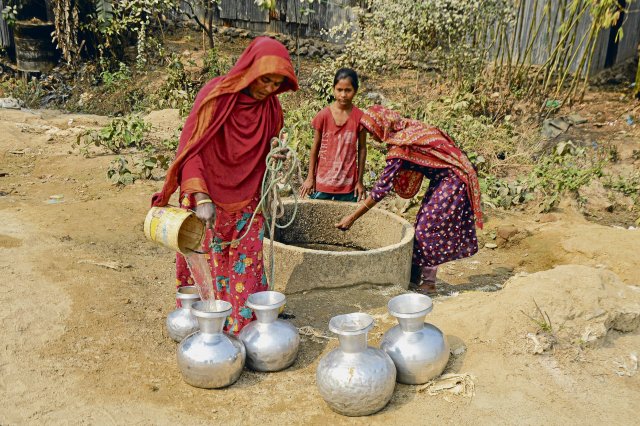Many drinking water wells in Bangladesh significantly exceed limits for arsenic.
Photo: IMAGO/ZUMA/Rafayat Haque Khan
Arsenic in drinking water – this is by no means a new problem, especially in Bangladesh, where many people use wells, and has already affected millions of families. There could be significantly more in the future: According to recent studies, the advancing climate change, from which the South Asian country is already suffering more than others, threatens to further exacerbate the strain on this most basic foodstuff. This is the result of a report published in mid-January Study.
Until Bangladesh gained statehood in the early 1970s, the country’s residents primarily met their drinking water needs from above-ground sources. At that time, however, the government, the United Nations Children’s Fund (Unicef) and various non-governmental organizations began drilling wells across the country on a large scale – an estimated ten to eleven million over time. This may have significantly improved the general water supply, especially for children, in many places. But the secured supply does not come without negative side effects. 49 percent of the tapped groundwater is considered to be contaminated with arsenic. The World Health Organization (WHO) classifies all levels above ten micrograms per liter as dangerous – but in Bangladesh the levels are usually much higher. The long-term consumption of drinking water that contains a lot of arsenic leads, among other things, to a rapid increase in the number of various cancers among the local population. Arsenic is transported to all organs via the bloodstream and is deposited in the lungs, liver, skin tissue and even in areas of the brain.
Public health emergency
On its website, the WHO also lists India, Pakistan and Nepal in the regional neighborhood as well as Argentina, Chile, Mexico and Cambodia as more affected countries, even larger areas in the USA and China are suffering from contamination of local drinking water supplies. However, nowhere in the world does the problem reach the dimensions that it has had for decades in Bangladesh. In the WHO bulletin, Mahfuzar Rahman, team leader of the Dhaka-based development aid organization Bangladesh Rural Advancement Committee (BRAC), and two co-authors described the situation as a “public health emergency” back in 2000. Almost at the same time, Masud Karim addressed the major dangers in an article published on the Sciencedirect.com portal using patient numbers from various clinics. The first studies date back to the early 1990s.
Teller and Rand – the podcast on international politics

Stephanie Schoell
Plate and rim is the nd.Podcast on international politics. Every month, Andreas Krämer and Rob Wessel serve up current political events from around the world and reveal what’s going on outside of media attention. Left-wing, critical, anti-colonialist.
The arsenic is introduced into the soil in particular with subsurface sediments in the river system of the Ganges and Brahmaputra, which originate in the Himalayas, and is dissolved through certain chemical processes in such a way that it reaches the groundwater. Although the legal limit in Bangladesh is 50 micrograms per liter, which is five times what the WHO still classifies as acceptable, the real levels are often far higher, with values of 100 to 300 micrograms, according to a report from 2022 Study by a team from the Jichi Medical University School of Medicine from Japan. In addition to the greatly increased risk of cancer, the three-person team of authors lists various other consequences: pregnant women suffer from frequent premature births and stillbirths, children are born with extremely low weight and later show growth disorders, a low IQ, a weak immune system or neurological problems. According to another article from 2018, around 50 million people in Bangladesh are latently exposed to these dangers – that is more than a third of the 140 million worldwide who the WHO classifies as being at risk from elevated arsenic concentrations. According to previous studies, there are elevated arsenic concentrations in drinking water in 62 of the country’s 64 administrative units; the situation is acute, with 80 to 100 percent contaminated wells, especially in a wide strip immediately south of the capital Dhaka.
Longer monsoons change the chemistry
The most harmful arsenic compounds include water-soluble arsenic (arsenic(III) oxide, As2O3). If there is not enough oxygen for the arsenic to bind into less dangerous, insoluble salts of arsenic acid (arsenates), it is released. It is precisely this lack of oxygen input from the atmosphere that occurs when areas are flooded for weeks during the monsoon season. But it’s not just longer and longer periods of flooding caused by climate change that are making the problem worse, according to the current study. The so-called salt effect also plays a role: Arsenic is dissolved from various minerals (especially iron and manganese compounds) and washed into the groundwater wells. The research suggested “that any process that increases salinity, such as annual flooding, is likely to increase the release of arsenic oxyanions from sediments into drinking water from Bangladesh’s wells through the salt effect,” according to the team of authors – a factor that is particularly relevant southern parts of the country, where the delta of the Ganges and Brahmaputra flows into the Bay of Bengal and the rise in sea levels as a result of climate change has a corresponding impact. Salt water is penetrating more and more into the interior of the country.
“Chronic arsenic poisoning from drinking water (…) is a real problem, not a theoretical exercise,” Seth Frisbie, lead author of the study, is quoted as saying in the British “Guardian.” The chemist, Professor Emeritus at Norwich University, points to a village he visited as a serious example: None of the people there were older than 30, the premature deaths were apparently so extreme. One of the wells Frisbie examined even had a reading of 448 milligrams of arsenic per liter. There has long been talk of the “largest mass poisoning in the world” in Bangladesh due to arsenic.
Become a member of the nd.Genossenschaft!
Since January 1, 2022, the »nd« will be published as an independent left-wing newspaper owned by the staff and readers. Be there and support media diversity and visible left-wing positions as a cooperative member. Fill out the membership application now.
More information on www.dasnd.de/genossenschaft
